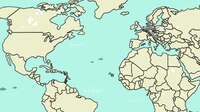Introduction
Studying monkeys with Eckhard
For this purpose, he has set up the Estación Biológica Quebrada Blanco (EBQB). It is part of the German Primate Center – Leibniz Institute for Primate Research in Göttingen.
Join us on a trip to the Amazon rainforest
Journey to the Amazon
Everyday life at camp
Studying monkeys
Endangered paradise
Stay curious!
Journey to the Amazon
We travel to the Amazon
Deep into the rainforest
Rivers are the main traffic routes
"The long journey on the colectivo...
Stopover in Chino
Upstream in a canoe
A second boat is loaded with enough food for three weeks in the rainforest – and of course Eckhard's expedition case.
It contains all the utensils needed to observe the monkeys: decent binoculars, a laptop, notepads, pencils and sample containers.
Solid ground underfoot again at last!
"We're almost there!"
Everyday life at camp
Finally there!
"For every hectare of forest here, there are around 300 different tree species and over 90 different mammal species," says Eckhard.
In this area, the tropical lowland rainforest is still largely intact.
Meeting point kitchen
Eckhard explains: "We have no fridge, so the fresh food is gone within the first week and a half."
"You learn to appreciate canned food here," he laughs, and adds: "We buy fresh fish and fruit in the neighboring village whenever possible."
A meal in the wilderness
Eckhard recommends: "Try some Avena - it's a porridge made from oat flakes, milk powder, cocoa and sugar."
For dinner, there is usually a starch-based side dish such as rice, noodles, plantains or yuca (cassava) in combination with legumes and fresh vegetables, while stocks last.
"There's yet another sloth in the toilet!"
There is a good reason for this: Sloths used to climb into the open outhouse until a new brick toilet hut was built. As human diseases can be transmitted to wild animals, a "sloth-proof" toilet was needed.
The "bathroom" is a small creek near the huts.
Sleeping under mosquito nets
Determined, we set off into the forest. We look for the sleeping tree where the monkeys went to rest in the late afternoon of the previous day.
Studying monkeys
Deep into the forest
Just in time
We then follow the monkeys through the forest for about ten hours, constantly looking upwards.
So, where are they now?
Back at the camp
Read the following pages to find out what these little monkeys can do!
Tamarins are diligent "gardeners".
The small monkeys play an important role in the forest ecosystem: They spread the seeds of eaten fruit and thus contribute to the regeneration of the forest.
"Gulp"
Eckhard says: "To achieve a comparable performance, a person would have to swallow a mango pit."
Safer together.
The larger group offers the animals better protection from predators such as birds of prey and snakes, as more eyes and ears detect predators more quickly.
Endangered paradise
Let's take a step back and look at the rainforest as a whole.
Green lungs, ...
Seen from our part of the world, the Amazon rainforest is far away, and yet it plays an essential role in all of our lives.
The rainforest is in danger
Our contribution
The research station makes a small contribution to preserving the forest for the monkeys and all other animals.
Eckhard's farewell tip:Stay curious!
Stay curious!
Stay curious!

Blog entry by a field researcher
Field Notes: Peru Pilot Trip
More about research on monkeys
The German Primate Center in Göttingen (DPZ)
Catalog with background information (in German)
The turbulent history of field research in the Amazon
Prof. Eckhard W. Heymann in an interview (in German)
Why are monkeys becoming extinct? How does this affect humans? (Youtube)
Report on the EBQB station (in German)
On the occasion of the exhibition "In the Jungle" at the German Primate Center (Sat1 regional)































 Studying monkeys with Eckhard
Studying monkeys with Eckhard
 Join us on a trip to the Amazon rainforest
Join us on a trip to the Amazon rainforest
 Welcome to the jungle
Welcome to the jungle
 We travel to the Amazon
We travel to the Amazon
 Deep into the rainforest
Deep into the rainforest
 Upstream
Upstream
 Rivers are the main traffic routes
Rivers are the main traffic routes
 "The long journey on the colectivo...
"The long journey on the colectivo...
 Stopover in Chino
Stopover in Chino
 Upstream in a canoe
Upstream in a canoe
 Solid ground underfoot again at last!
Solid ground underfoot again at last!
 "We're almost there!"
"We're almost there!"
 Finally there!
Finally there!
 Meeting point kitchen
Meeting point kitchen
 A meal in the wilderness
A meal in the wilderness
 "There's yet another sloth in the toilet!"
"There's yet another sloth in the toilet!"
 The "bathroom" is a small creek near the huts.
The "bathroom" is a small creek near the huts.
 Sleeping under mosquito nets
Sleeping under mosquito nets
 Deep into the forest
Deep into the forest
 Just in time
Just in time
 So, where are they now?
So, where are they now?
 Back at the camp
Back at the camp
 Tamarins are diligent "gardeners".
Tamarins are diligent "gardeners".
 "Gulp"
"Gulp"
 Safer together.
Safer together.
 Let's take a step back and look at the rainforest as a whole.
Let's take a step back and look at the rainforest as a whole.
 Green lungs, ...
Green lungs, ...
 The rainforest is in danger
The rainforest is in danger
 Our contribution
Our contribution
 Stay curious!
Stay curious!